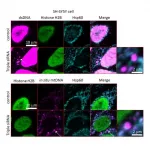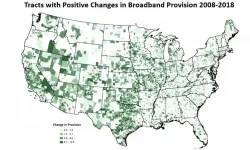Pfizer COVID-19 vaccine protective against SARS-CoV-2 variants
2021-06-10
(Press-News.org) Washington, D.C. - June 9, 2021 - The Pfizer COVID-19 vaccine is protective against several SARS-CoV-2 variants that have emerged, according to new research presented in the journal mBio, an open-access journal of the American Society for Microbiology. While this is good news, the study also found that the only approved monoclonal antibody therapy for SARS-CoV-2 might be less effective against SARS-CoV-2 variants in laboratory experiments.
"The vaccines provide very strong protection against the earlier forms of the virus as well as the newer variants. This is an important point because I have heard people say that they don't think there is a reason to get vaccinated, because the vaccine isn't going to work against the variants, but that is not true--the vaccine will work against the variants," said Nathaniel "Ned" Landau, Ph.D., professor in the Department of Microbiology at the NYU Grossman School of Medicine, in New York City.
To conduct their research, Dr. Landau and colleagues in the NYU Department of Microbiology and NYU Langone Vaccine Center created a panel of pseudotype viruses that combined the HIV virus and SARS-CoV-2 spike protein. Pseudotype viruses are replication-defective viral particles formed with a structural and enzymatic core from one virus and the envelope glycoprotein of another, that have been proven to be useful as research tools with little associated risk. "The SARS-CoV-2 spike protein is important, because it is the only structure on the virus that is exposed to the outside. The spike protein is what sticks out from the virus; it is what the immune system recognizes and what allows the virus to stick onto target cells," said Dr. Landau.
There are 2 reasons the researchers chose HIV to create their chimeric viruses. First, HIV is not particular about incorporating the HIV spike protein; it will take most any virus spike protein. Second, the HIV virus has been engineered to carry 2 reporter genes that allow researchers to study virus entry, antibody binding, and antibody neutralization. When the virus infects a cell, the cell turns green and produces luciferase, the enzyme that makes fireflies light up at night. This provides a quick and easy way to count how many cells have been infected. "The spike protein-pseudotyped lentiviruses are extremely useful experimental tools. They were developed in the course of HIV research. They are less biohazardous and easier to work with in the lab," said Dr. Landau.
The researchers created a panel of pseudotype viruses using the spike proteins from 6 different variants of SARS-CoV-2: the B.1.1.7 lineage variant identified in the United Kingdom, the B.1.351 lineage variant identified in South Africa, the B.1.1.248 lineage variant identified in Brazil, the COH.20G/677H lineage variant identified in Columbus Ohio, the 20A.EUs variant identified in Spain and later found elsewhere in Europe, and the Mink cluster 5 spike proteins located in minks in Denmark. They then mixed these pseudotype viruses with serum from either people who had received the Pfizer SARS CoV-2 vaccine or people who had already had COVID-19.
The researchers found that convalescent sera neutralize pseudotyped viruses with the 6 variants with only a small loss in titer. They also found that the Pfizer BNT162b2 vaccination worked just as well against the majority of variants as the earlier virus, but the vaccine neutralized the South African variant and the Brazil variant with a 3-fold decrease in titer, an effect attributable to the mutation E484K. Dr. Landau said that people should not be concerned about these results, however.
"Our interpretation of the results is that the vaccine antibodies are very powerful, and even if you lose 3-fold of the titer, there is still plenty of antibody there to neutralize the virus. We believe the findings demonstrate that the vaccines will remain protective against the variants that we tested," said Dr. Landau. "While it's not reported in this paper, we have done the same experiments with the Moderna vaccine and got similar results."
In another experiment, the researchers tested Regeneron Pharmaceuticals REGN-COV2, a 2 recombinant monoclonal antibody cocktail consisting of casirivamab and imdevimab, that has been effective at decreasing symptoms of individuals with COVID-19 and keeping them out of the intensive care unit. The researchers found that casirivamab had lost some of its neutralizing activity against the South African and Brazilian variants and the cocktail was 9- to 15-fold decreased in titer.
"One of the Regeneron antibodies is affected by the E484K mutation, and as a result the cocktail loses some of its neutralizing activity," said Dr. Landau. "The question with this work is 'how do the laboratory findings translate into clinical effects, that is what will happen when you treat a patient infected with one of the variants?' We cannot say for sure. We will only know when the clinical data comes in."
INFORMATION:
The American Society for Microbiology is one of the largest professional societies dedicated to the life sciences and is composed of 30,000 scientists and health practitioners. ASM's mission is to promote and advance the microbial sciences.
ASM advances the microbial sciences through conferences, publications, certifications, educational opportunities and advocacy efforts. It enhances laboratory capacity around the globe through training and resources. It provides a network for scientists in academia, industry and clinical settings. Additionally, ASM promotes a deeper understanding of the microbial sciences to diverse audiences.
ELSE PRESS RELEASES FROM THIS DATE:
2021-06-10
Scientists say naked mole rats - a rodent native to West Africa - may hold the key to new treatments for degenerative diseases such as cancer and dementia.
The reclusive animals have a lifespan far in excess of other rodents - for example, mice and rats live about two years, whereas naked mole rats can live for 40 or 50 years.
Researchers at the University of Bradford say the animals have a unique DNA repair mechanism that enables them to prevent cancers and other degenerative conditions, including dementia.
Cancer resistant
Professor Sherif El-Khamisy, Director of the Institute of Cancer Therapeutics at the University, said: "Naked mole rats are fascinating ...
2021-06-10
Niigata, Japan - Researchers from Brain Research Institute, Niigata University, Japan may have unraveled a new approach that could revolutionize the treatment, prevention, and possibly reversal of the damages that could lead to Parkinson's Disease (PD). This novel finding utilizing the cellular and zebrafish models, demonstrated how the leakage of mitochondrial dsDNA into the cytosol environment of the cell can contribute to the impairment of brain tissue of patients with PD.
Parkinson's disease is the second most common neurodegenerative disease, and its prevalence ...
2021-06-10
Surgeons can ease their patients' pain from common operations without prescribing opioids, and avoid the possibility of starting someone on a path to long-term use, a pair of new studies suggests.
Treating post-surgery pain with non-opioid pain medications such as ibuprofen or acetaminophen didn't lead to higher pain levels or more serious issues during recovery, and didn't dampen patients' satisfaction with their care, according to new results from a study of more than 22,000 patients who had one of seven common operations at 70 hospitals.
The team behind the study has also produced a free, evidence-based guide for surgeons and other acute care providers, ...
2021-06-10
People often think about human behavior in terms of what is happening in the present--reading a newspaper, driving a car, or catching a football. But other dimensions of behavior extend over weeks, months, and years.
Examples include a child learning how to read; an athlete recovering from a concussion; or a person turning 50 and wondering where all the time has gone. These are not changes that people perceive on a day-to-day basis. They just suddenly realize they're older, healed, or have a new development skill.
"The field of neuroscience looks at the brain in multiple ways," says Franco Pestilli, a neuroscientist at The University of Texas at Austin (UT Austin). "For ...
2021-06-10
Researchers have discovered that the common bacteria E. coli can be deployed as a sustainable way to convert post-consumer plastic into vanillin, a new study reveals.
Vanillin is the primary component of extracted vanilla beans and is responsible for the characteristic taste and smell of vanilla.
The transformation could boost the circular economy, which aims to eliminate waste, keep products and materials in use and have positive impacts for synthetic biology, experts say.
The world's plastic crisis has seen an urgent need to develop new methods to recycle polyethylene terephthalate (PET) - the strong, lightweight plastic derived from non-renewable materials such as oil and gas and widely used for ...
2021-06-10
High-speed internet access has gone from an amenity to a necessity for working and learning from home, and the COVID-19 pandemic has more clearly revealed the disadvantages for American households that lack a broadband connection.
To tackle this problem, Michigan State University researchers have developed a new tool to smooth the collection of federal broadband access data that helps pinpoint coverage gaps across the U.S. The research was published May 26 In the journal PLOS ONE.
"Nearly 21% of students in urban areas are without at-home broadband, while 25% and 37% lack at-home broadband in suburban ...
2021-06-10
Researchers at Michigan Medicine found a subset of middle-aged men with cerebral palsy are up to 5.6 times more likely to suffer fractures than men without the disorder.
"We are not really sure why this happens," said Edward A. Hurvitz, M.D., professor and chair of the Michigan Medicine Department of Physical Therapy and Rehabilitation. "It may be related to structural differences that occur during adolescent growth, or to greater bone mineral loss at earlier age for people with cerebral palsy compared to peers."
For a study published in BONE, the team examined the timing and site of bone fractures for around ...
2021-06-10
JUNE 10, 2021, NEW YORK - A Ludwig Cancer Research study adds to growing evidence that immune cells known as macrophages inhabiting the body cavities that house our vital organs can aid tumor growth by distracting the immune system's cancer-killing CD8+ T cells.
Reported in the current issue of Cancer Cell and led by Ludwig investigators Taha Merghoub and Jedd Wolchok at Memorial Sloan Kettering (MSK) and Charles Rudin of MSK, the study shows that cavity-resident macrophages express high levels of Tim-4, a receptor for phosphatidylserine (PS), a molecule that they surprisingly ...
2021-06-10
Earlier this year, the US National Institutes of Health (NIH) acknowledged the impact of structural racism on biomedical science and committed to doing more to dismantle it. Now, in a commentary appearing June 10 in the journal Cell, NIH Director Francis Collins (@NIHDirector) and colleagues describe the NIH's UNITE initiative and how it differs from the agency's previous diversity, equity, and inclusion efforts.
The UNITE initiative was launched on February 26, 2021 and, for the first time, brings together all 27 NIH institutes to focus on structural racism. It is made up of five committees with members from across the agency and aims to accelerate efforts to address racism ...
2021-06-10
A new device that fits over a person's ears and enables non-invasive measurement of real-time changes in blood alcohol levels through the skin is presented in a proof-of-principle study in Scientific Reports.
The device, devised by Kohji Mitsubayashi and colleagues, consists of a modified pair of commercial earmuffs that collect gas released through the skin of a person's ears, and an ethanol vapour sensor. If the sensor detects ethanol vapour, it releases light, the intensity of which allows for ethanol concentrations to be calculated.
The authors used their device to continuously monitor ethanol vapour released through the ears of three male volunteers, who had consumed alcohol with a concentration of 0.4 g per kg body weight, for 140 ...
LAST 30 PRESS RELEASES:
[Press-News.org] Pfizer COVID-19 vaccine protective against SARS-CoV-2 variants



